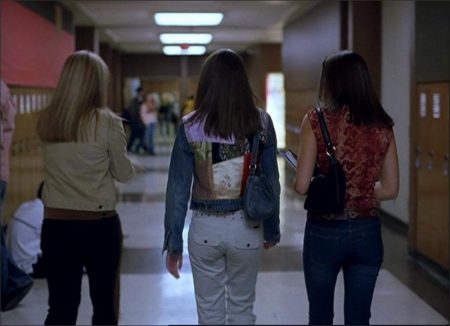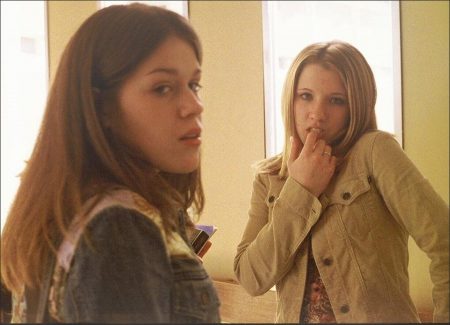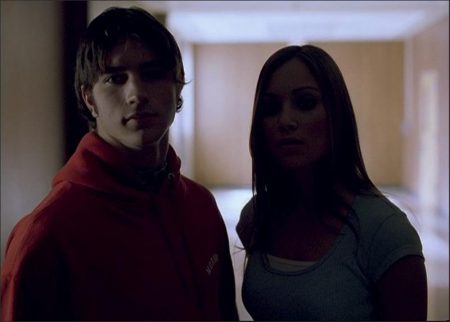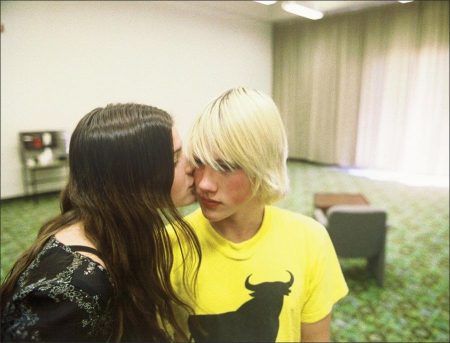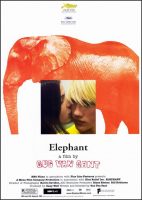Taglines: An ordinary high school day. Except that it’s not.
The story is about two high school students, Alex (Alex Frost) and Eric (Eric Deulen), two close friends and students in a suburb of Portland, who calmly plan and perform a mass execution of their classmates and school administrators in the course of one day. Eric and Alex are seemingly ordinary, and very much a part of the fabric of the high school and its array of student actions.
In fact, it’s hard to distinguish them from all the other students. Alex plays classical piano whereas Eric plays video games. They calmly watch Nazi programs on TV and purchase firearms over the Internet. They seem just as ordinary and interesting as any of the other students. They analytically draw up plans for their merciless killing spree, indicating that they have enough bombs and ordinance to last the afternoon. They walk through the school, killing several of their school peers, and there is no rescue from the authorities.
Elephant is a 2003 drama film edited, written and directed by Gus Van Sant. It takes place in the fictional Watt High School, in the suburbs of Portland, Oregon, and chronicles the events surrounding a school shooting, based in part on the 1999 Columbine High School massacre. The film begins a short time before the shooting occurs, following the lives of several characters both in and out of school, who are unaware of what is about to unfold. The film stars mostly new or non-professional actors, including John Robinson, Alex Frost, and Eric Deulen.
Elephant is the second film in Van Sant’s “Death Trilogy”—the first is Gerry (2002) and the third Last Days (2005)—all three of which are based on actual events. Elephant was generally acclaimed by critics and received the Palme d’Or at the 2003 Cannes Film Festival, in which Patrice Chéreau was the head of the jury. The film was controversial for its subject matter and allegations of influence on the Red Lake shootings.
The film competed at the Cannes Film Festival in May 2003. Van Sant claimed audiences in attendance at Cannes argued over its quality, leading to altercations. Elephant premiered in North America at a benefit for the Outside In youth shelter at the Arlene Schnitzer Concert Hall, in Portland, Oregon, on Saturday, October 4, 2003, with several teenagers who appeared in the film in attendance. The film was released for incremental distribution by HBO in 38 theaters in the United States, beginning October 24, 2003.
The film opened in a limited release in North America on October 24, 2003 in 6 theaters and grossed $93,356 with an average of $15,559 per theater ranking 36th at the box office. It ended up making $1,266,955 domestically and $8,745,067 elsewhere for a total of $10,012,022, above its $3 million budget.
Film Review for The Elephant
Gus Van Sant’s “Elephant” is a record of a day at a high school like Columbine, on the day of a massacre much like the one that left 13 dead. It offers no explanation for the tragedy, no insights into the psyches of the killers, no theories about teenagers or society or guns or psychopathic behavior. It simply looks at the day as it unfolds, and that is a brave and radical act; it refuses to supply reasons and assign cures, so that we can close the case and move on.
Van Sant seems to believe there are no reasons for Columbine and no remedies to prevent senseless violence from happening again. Many viewers will leave this film as unsatisfied and angry as Variety’s Todd McCarthy, who wrote after it won the Golden Palm at Cannes 2003 that it was “pointless at best and irresponsible at worst.” I think its responsibility comes precisely in its refusal to provide a point.
Let me tell you a story. The day after Columbine, I was interviewed for the Tom Brokaw news program. The reporter had been assigned a theory and was seeking sound bites to support it. “Wouldn’t you say,” she asked, “that killings like this are influenced by violent movies?” No, I said, I wouldn’t say that. “But what about ‘Basketball Diaries’?” she asked. “Doesn’t that have a scene of a boy walking into a school with a machine gun?” The obscure 1995 Leonardo Di Caprio movie did indeed have a brief fantasy scene of that nature, I said, but the movie failed at the box office (it grossed only $2.5 million), and it’s unlikely the Columbine killers saw it.
The reporter looked disappointed, so I offered her my theory. “Events like this,” I said, “if they are influenced by anything, are influenced by news programs like your own. When an unbalanced kid walks into a school and starts shooting, it becomes a major media event. Cable news drops ordinary programming and goes around the clock with it. The story is assigned a logo and a theme song; these two kids were packaged as the Trench Coat Mafia. The message is clear to other disturbed kids around the country: If I shoot up my school, I can be famous. The TV will talk about nothing else but me. Experts will try to figure out what I was thinking. The kids and teachers at school will see they shouldn’t have messed with me. I’ll go out in a blaze of glory.”
In short, I said, events like Columbine are influenced far less by violent movies than by CNN, the NBC Nightly News and all the other news media, who glorify the killers in the guise of “explaining” them. I commended the policy at the Sun-Times, where our editor said the paper would no longer feature school killings on Page 1. The reporter thanked me and turned off the camera. Of course the interview was never used. They found plenty of talking heads to condemn violent movies, and everybody was happy.
Van Sant’s “Elephant” is a violent movie in the sense that many innocent people are shot dead. But it isn’t violent in the way it presents those deaths. There is no pumped-up style, no lingering, no release, no climax. Just implacable, poker-faced, flat, uninflected death. Truffaut said it was hard to make an anti-war film because war was exciting even if you were against it. Van Sant has made an anti-violence film by draining violence of energy, purpose, glamor, reward and social context. It just happens. I doubt that “Elephant” will ever inspire anyone to copy what they see on the screen. Much more than the insipid message movies shown in social studies classes, it might inspire useful discussion and soul-searching among high school students.
Van Sant simply follows a number of students and teachers as they arrive at the school and go about their daily routines. Some of them intersect with the killers, and many of those die. Others escape for no particular reason. The movie is told mostly in long tracking shots; by avoiding cuts between closeups and medium shots, Van Sant also avoids the film grammar that goes along with such cuts, and so his visual strategy doesn’t load the dice or try to tell us anything. It simply watches.
At one point he follows a tall, confident African-American student in a very long tracking shot as he walks into the school and down the corridors, and all of our experience as filmgoers leads us to believe this action will have definitive consequences; the kid embodies all those movie heroes who walk into hostage situations and talk the bad guy out of his gun. But it doesn’t happen like that, and Van Sant sidesteps all the conventional modes of movie behavior and simply shows us sad, sudden death without purpose.
“I want the audience to make its own observations and draw its own conclusions,” Van Sant told me at Cannes. “Who knows why those boys acted as they did?” He is honest enough to admit that he does not. Of course a movie about a tragedy that does not explain the tragedy — that provides no personal of social “reasons” and offers no “solutions” — is almost against the law in the American entertainment industry. When it comes to tragedy, Hollywood is in the catharsis business.
Van Sant would have found it difficult to find financing for any version of this story (Columbine isn’t “commercial”), but to tell it on a small budget, without stars or a formula screenplay, is unthinkable. He found the freedom to make the film, he said, because of the success of his “Good Will Hunting,” which gave him financial independence: “I came to realize since I had no need to make a lot of money, I should make films I find interesting, regardless of their outcome and audience.”
Elephant (2004)
Directed by: Gus Van Sant
Starring: Elias McConnell, Alex Frost, Eric Deulen, John Robinson, Carrie Finklea, Nicole George, Brittany Mountain, Alicia Miles, Kristen Hicks, Matt Malloy
Screenplay by: Gus Van Sant
Cinematography by: Harris Savides
Film Editing by: Gus Van Sant
Costume Design by: Marychris Mass
Art Direction by: Benjamin Hayden
MPAA Rating: R for disturbing violent content, language, brief sexuality and drug use – all involving teens.
Distributed by: Fine Line Features
Release Date: May 4, 2004
Visits: 229
